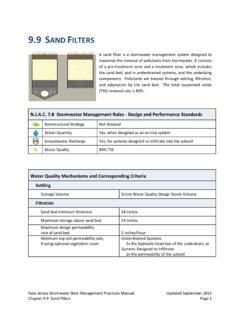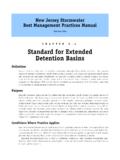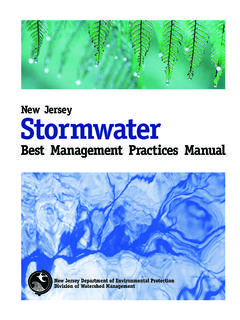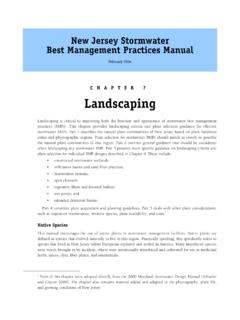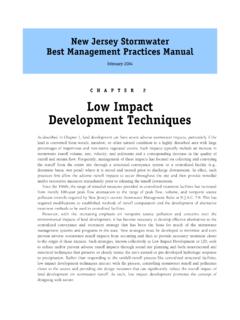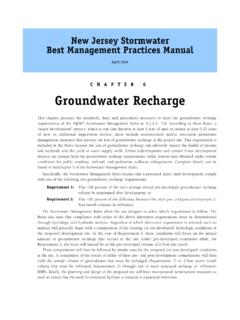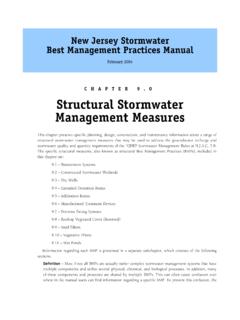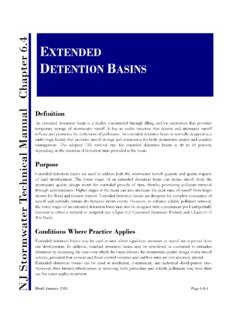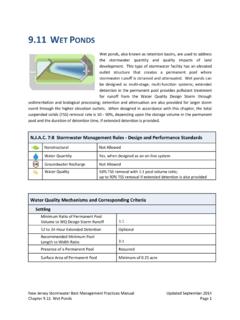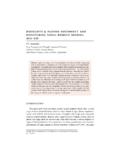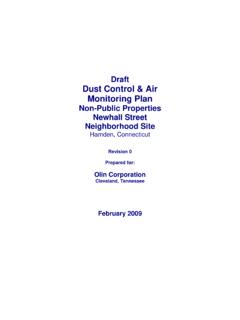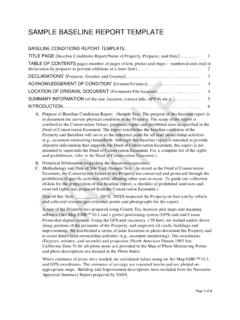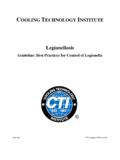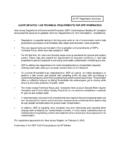Transcription of StormFilter Inspection and Maintenance Procedures
1 StormFilter Inspection and Maintenance ProceduresENGINEERED SOLUTIONSIn addition to these two activities, it is important to check the condition of the StormFilter unit after major storms for potential damage caused by high flows and for high sediment accumulation that may be caused by localized erosion in the drainage area. It may be necessary to adjust the Inspection / Maintenance schedule depending on the actual operating conditions encountered by the system. In general, Inspection activities can be conducted at any time, and Maintenance should occur, if warranted, during dryer months in late summer to early Frequency The primary factor for determining frequency of Maintenance for the StormFilter is sediment properly functioning system will remove solids from water by trapping particulates in the porous structure of the filter media inside the cartridges. The flow through the system will naturally decrease as more and more particulates are trapped.
2 Eventually the flow through the cartridges will be low enough to require replacement. It may be possible to extend the usable span of the cartridges by removing sediment from upstream trapping devices on a routine as-needed basis, in order to prevent material from being re-suspended and discharged to the StormFilter treatment average Maintenance lifecycle is approximately 1-5 years. Site conditions greatly influence Maintenance requirements. StormFilter units located in areas with erosion or active construction may need to be inspected and maintained more often than those with fully stabilized surface requirements or a chemical spill can shift Maintenance timing as well. The Maintenance frequency may be adjusted as additional monitoring information becomes available during the Inspection program. Areas that develop known problems should be inspected more frequently than areas that demonstrate no problems, particularly after major storms.
3 Ultimately, Inspection and Maintenance activities should be scheduled based on the historic records and characteristics of an individual StormFilter system or site. It is recommended that the site owner develop a database to properly manage StormFilter Inspection and Maintenance 3 Maintenance GuidelinesThe primary purpose of the Stormwater Management StormFilter is to filter and prevent pollutants from entering our waterways.
4 Like any effective filtration system, periodically these pollutants must be removed to restore the StormFilter to its full efficiency and requirements and frequency are dependent on the pollutant load characteristics of each site. Maintenance activities may be required in the event of a chemical spill or due to excessive sediment loading from site erosion or extreme storms. It is a good practice to inspect the system after major storm ProceduresAlthough there are many effective Maintenance options, we believe the following procedure to be efficient, using common equipment and existing Maintenance protocols. The following two-step procedure is recommended::1. Inspection Inspection of the vault interior to determine the need for Maintenance Cartridge replacement Sediment removalInspection and Maintenance Timing At least one scheduled Inspection should take place per year with Maintenance following as , an Inspection should be done before the winter season.
5 During the Inspection the need for Maintenance should be determined and, if disposal during Maintenance will be required, samples of the accumulated sediments and media should be , if warranted, a Maintenance (replacement of the filter cartridges and removal of accumulated sediments) should be performed during periods of dry 3 Inspection ProceduresThe primary goal of an Inspection is to assess the condition of the cartridges relative to the level of visual sediment loading as it relates to decreased treatment capacity.
6 It may be desirable to conduct this Inspection during a storm to observe the relative flow through the filter cartridges. If the submerged cartridges are severely plugged, then typically large amounts of sediments will be present and very little flow will be discharged from the drainage pipes. If this is the case, then Maintenance is warranted and the cartridges need to be : In the case of a spill, the worker should abort Inspection activities until the proper guidance is obtained. Notify the local hazard control agency and Contech Engineered Solutions conduct an Inspection :Important: Inspection should be performed by a person who is familiar with the operation and configuration of the StormFilter treatment If applicable, set up safety equipment to protect and notify surrounding vehicle and pedestrian Visually inspect the external condition of the unit and take notes concerning Open the access portals to the vault and allow the system Without entering the vault, visually inspect the inside of the unit, and note accumulations of liquids and Be sure to record the level of sediment build-up on the floor of the vault, in the forebay, and on top of the cartridges.
7 If flow is occurring, note the flow of water per drainage pipe. Record all observations. Digital pictures are valuable for historical Close and fasten the access portals. 7. Remove safety equipment. 8. If appropriate, make notes about the local drainage area relative to ongoing construction, erosion problems, or high loading of other materials to the Discuss conditions that suggest Maintenance and make decision as to weather or not Maintenance is Decision TreeThe need for Maintenance is typically based on results of the Inspection . The following Maintenance Decision Tree should be used as a general guide. (Other factors, such as Regulatory Requirements, may need to be considered)1. Sediment loading on the vault If >4 of accumulated sediment, Maintenance is Sediment loading on top of the If >1/4 of accumulation, Maintenance is Submerged If >4 of static water above cartridge bottom for more than 24 hours after end of rain event, Maintenance is required.
8 (Catch basins have standing water in the cartridge bay.)4. Plugged If pore space between media granules is absent, Maintenance is Bypass If Inspection is conducted during an average rain fall event and StormFilter remains in bypass condition (water over the internal outlet baffle wall or submerged cartridges), Maintenance is Hazardous material If hazardous material release (automotive fluids or other) is reported, Maintenance is Pronounced scum If pronounced scum line (say 1/4 thick) is present above top cap, Maintenance is : Care must be used to avoid damaging the cartridges during removal and installation. The cost of repairing components damaged during Maintenance will be the responsibility of the Set the used cartridge aside or load onto the hauling truck. D. Continue steps a through c until all cartridges have been 2:A. This activity will require that Maintenance personnel enter the vault to remove the cartridges from the under drain manifold and place them under the vault opening for lifting (removal).
9 Disconnect each filter cartridge from the underdrain connector by rotating counterclockwise 1/4 of a turn. Roll the loose cartridge, on edge, to a convenient spot beneath the vault Unscrew the cartridge Remove the cartridge hood and At location under structure access, tip the cartridge on its Empty the cartridge onto the vault floor. Reassemble the empty Set the empty, used cartridge aside or load onto the hauling Continue steps a through e until all cartridges have been 5 MaintenanceDepending on the configuration of the particular system, Maintenance personnel will be required to enter the vault to perform the Maintenance .
10 Important: If vault entry is required, OSHA rules for confined space entry must be followed. Filter cartridge replacement should occur during dry weather. It may be necessary to plug the filter inlet pipe if base flows is cartridges can be delivered to the site or customers facility. Information concerning how to obtain the replacement cartridges is available from Contech Engineered : In the case of a spill, the Maintenance personnel should abort Maintenance activities until the proper guidance is obtained. Notify the local hazard control agency and Contech Engineered Solutions conduct cartridge replacement and sediment removal Maintenance :1. If applicable, set up safety equipment to protect Maintenance personnel and pedestrians from site Visually inspect the external condition of the unit and take notes concerning Open the doors (access portals) to the vault and allow the system to Without entering the vault, give the inside of the unit, including components, a general condition Inspection .
